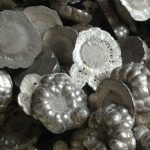Notice: Undefined index: sith_hide_share in /www/sites/alloy.wiki/index/wp-content/themes/likegoogle/single.php on line 32
Deprecated: get_settings is deprecated since version 2.1.0! Use get_option() instead. in /www/sites/alloy.wiki/index/wp-includes/functions.php on line 4862
The operation of adjusting the composition of liquid titanium alloy in the process of making titanium rod is called alloying. The alloying of titanium rod made by traditional electric furnace in metallurgical engineering is generally carried out in the late oxidation and early recovery stage, and the alloy composition is fine-tuned in the late recovery stage, before titanium extraction or titanium extraction process. However, the alloying of titanium rod in modern electric furnace is generally finished in the process of titanium discharge, and the alloying in titanium discharge is pre-alloyed, and the accurate alloy composition adjustment is finally finished in the refining furnace. Alloying operation mainly refers to the time and amount of alloying.

Alloy participation time. The general principle of metallurgical engineering participation in ferroalloy is: the elements with high melting point and not easy to oxidize can be added early, such as nickel can participate with the charge, the yield is still above 95%; Low melting point, late participation of oxidation, such as iron borate in the titanium coating in the process of titanium extraction, recovery only about 50%.
In addition, deoxidation and alloying operations can not be completely separated. Generally speaking, as deoxidizing elements are added first, alloying elements are added later; Deoxidation ability is stronger, and more valuable alloy elements, should be in the titanium liquid degassing excellent conditions to participate. For example, the participation of easy oxidizing elements and the purpose should be: 2~3 minutes before titanium extraction, add aluminum deoxidation, add titanium fixed nitrogen, add boron in the titanium extraction process, and the recovery rate of boron. In this case, the yield of the three is 65%, 50% and 50% respectively.
Number of participants. Metallurgical engineering chemical composition has a great influence on titanium M and its function. The amount of alloy involved in the field can be calculated quickly and accurately according to the type of titanium rod, the amount of liquid titanium in the furnace, the composition in the furnace, the alloy composition and the alloy yield.
The electric furnace batching adopts high carbon, the main purpose of which is:
During the melting period of metallurgical engineering, carbon oxidizes before iron and then reduces the burning loss of iron.
Carburizing can reduce the melting point of waste titanium and accelerate melting.
The carbon – oxygen reaction formed the pool stirring, promoted the slag – titanium reaction, and was beneficial to the early desilting.
During the essence heating period, the vivid carbon-oxygen reaction expanded the slag-titanium interface, which was conducive to further dephosphorization, homogenization of liquid titanium composition and temperature, and the floating of gas and inclusions.
The vivid carbon-oxygen reaction contributes to the formation of foam slag, advances the heat transfer power, and accelerates the heating process.
The carbon quantity is closely related to the carbon participation method, oxygen blowing method, oxygen supply intensity and the power of furnace equipment.
Guest contributors are welcome at the Alloy Wiki.It is a weekly wiki and guide on alloy information and processing technology, while also about the vast array of opportunities that are present in manufacturing. Our team of writers consists of a Machining Material Supplier / Machinist / Tool and Die Maker, a Biomedical Engineer / Product Development Engineer, a Job Development Coordinator / Adjunct Professor, and a President and CEO of a manufacturing facility.
Link to this article:Metallurgical engineering alloying of titanium liquid in the process of making titanium rod
Reprint Statement: If there are no special instructions, all articles on this site are original. Please indicate the source for reprinting:Alloy Wiki,thanks!^^


